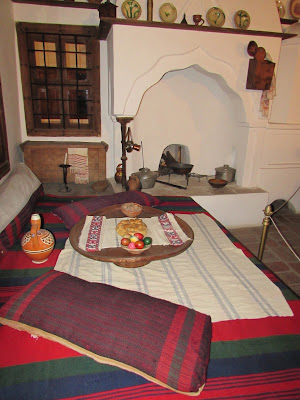Ruse is situated where the Danube forms a natural border between Romania and Bulgaria.
We joined a tour to the towns of Veliko Tarnova and Arbanassi. We first traveled by bus to Veliko Tarnovo, the capital of Bulgaria from 1186 to 1394.
Along the way we passed a stork's nest and by zooming in the camera, we could see the baby stork.
In Veliko Tarnova we enjoyed coffee and cookies with a view atop the fortification wall on Zarevez Hill.
Rose products are big in this town, and with time to wander and browse through the shops, we saw everything that could possibly be made from roses.
...as well as some traditional dress and embroidered linens.
Interesting painting on the side of this building.
 |
| Russian? |
...the colorful frescoes inside depicting some 3,500 figures.
 |
| Our local Bulgarian guide |
We listened to a group of 4 monks do a chanting. It was very interesting.
Arbanassi's population in the 17th and 18th centuries consisted mainly of eminent merchant families who traded in Transylvania and had the economic power to establish attractive dwellings and furnishings.
The Konstantsalieva House is an old Merchant's House open as a museum.
The Konstantsalieva House shows how the Turks influenced the life and culture of the Bulgarians in the 19th century.
Can you guess what this is?
 |
| The toilet! |
...and we always had fun with our friend Jack.
We ended our day with a stop by the fortress of Veliko Tarnova for photos...
...and then did a little shopping in the town.
We browsed the shops and observed the craftspeople at work.
And purchased a pottery bowl.
It was then back to the ship and we enjoyed a beautiful sunset on the Danube River..
As we cruised the Danube the next morning, the captain invited us into his wheelhouse and answered questions about navigating the river.
and then we arrived in Vidin, Bulgaria's main port on the river.
Irina guided us on a walking tour where we passed a memorial to those who died under the communist rule...
...a hotel which was once a Turkish bath house...
...and a mosque. We went inside the mosque and through a translator, a gentleman told us about the worship in the mosque.
Back outside, we headed down the park boulevard and came to a communist statue. It is the only communist monument remaining in a post-communist country that has not been destroyed or relocated (as was done in Budapest).
We passed the Jewish Synagogue which is now deserted. During World War II the city's Jews were sent to camps. Only a handful returned to Vidin after the war when it was under communist rule. Those few Jews could not financially maintain the building so it is deserted.
Then it was on to the fortress in Vidin, which is the best-preserved fortress from the Middle Ages in Eastern Europe.
We explored the fortress from the top, which overlooked a makeshift beach on the Danube.
After dinner that evening we were entertained by a Bulgarian dance group in traditional dress.
The next morning we had a day of leisurely cruising along a stretch of the Danube that was once a raging river pounding through deep gorges.
In the 1960s, Yugoslavia and Romania cooperated on a joint venture that raised the level of the Danube with a series of hydroelectric dams called the Iron Gates.
The Danube is now placid through the Iron Gates; its spectacular two-mile-long gorge now underwater. These locks changed the landscape upstream for more than 70 miles. 10-12 billion kilowatts are generated by 12 power units--6 turbines on each side, which covers 50 percent of Serbia's and 30 percent of Romania's power consumption. The project resettled 8000 people from Yugoslavia and 15000 from Romania after their towns had to be rebuilt higher up.
During our day of cruising, our Program Directors held a very interesting discussion on Life Under Communism, each sharing their experiences as young children in a communist country.
Here's just some of what they shared: Romania was under communism rule right after WWII. In the 1980s Ceausescu visited North Korea and liked the dictatorship style there. He exported 90 percent of Romania's goods to pay off debt. Then the country was penalized for paying early and the result was food shortages and long lines. People were forced to sign away their land, which became a collective farm and one never knew who was a member of the secret police. In school the books provided were written by the communists and after the revolution all history had to be relearned.
 |
| Nicolae Ceausescu |
In the late afternoon we entered the most scenic stretch of the lower Danube known as the Cataracts. It is a series of gorges that the river forms as it cuts its way through the mountains.
Trajan's Tablet is a Roman memorial plaque commemorating the completion of Trajan's military road, which was a road of planks sticking out of the cliff leading to a bridge he had built across the Danube. He was Roman Emperor from 98 to 117 AD.
Decebalus is a 130-foot statue of King Decebalus, the tallest rock sculpture in Europe. It took 10 years and 12 sculptors to complete.
At dinner with our friends on the ship.
And this ends another wonderful day on the Danube.
To continue reading about our river cruise, scroll up toward the top of this page and click in the column on the right the link entitled, "Serbia and Croatia".
















































































No comments:
Post a Comment